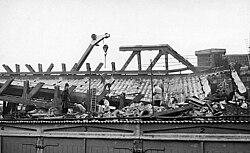Lewisham rail crash

The rail-over-rail bridge being dismantled
|
|
| Date | 4 December 1957 |
|---|---|
| Location | near St Johns |
| Coordinates | 51°28′03.3″N 0°01′09.3″W / 51.467583°N 0.019250°WCoordinates: 51°28′03.3″N 0°01′09.3″W / 51.467583°N 0.019250°W |
| Country | England |
| Rail line | South Eastern Main Line |
| Operator | British Railways |
| Cause | Signal passed at danger |
| Statistics | |
| Trains | 2 |
| Deaths | 90 |
| Injuries | 173 |
| List of UK rail accidents by year | |
The Lewisham rail crash occurred on the Lewisham by-pass line in London at about 6:20 pm on 4 December 1957. In dense fog, an electric train to Hayes stopped at a signal under a bridge and the following steam train to Ramsgate crashed into it, the collision causing the bridge to collapse onto the steam train. There were 90 fatalities and 109 people were detained in hospital. The bridge had to be cleared away and it was over a week before the lines under the bridge were reopened, and another month before the bridge had been rebuilt and traffic allowed over it.
The driver of the Ramsgate train was acquitted of manslaughter charges after two trials. The Ministry of Transport report found that he had failed to slow after passing two caution signals so he was unable to stop at the danger signal, concluding that an automatic warning system would have prevented the collision.
On the evening of 4 December 1957 there was dense fog in the London area and trains were running late. The 5:18 pm Charing Cross to Hayes, comprising electric multiple units totalling 10 cars and carrying nearly 1,500 passengers, stopped at a danger signal at Parks Bridge Junction on the Lewisham by-pass line, under a bridge carrying rail tracks over the line. Trains were running out of order because of the fog and the Parks Bridge Junction signalman wished to speak to the driver by the telephone at the signal to confirm the train's identity and destination. At approximately 6:20 pm it was struck from behind by a train from Cannon Street to Ramsgate via Folkestone, consisting of a steam locomotive hauling 11 coaches carrying about 700 passengers and travelling at about 30 miles per hour (48 km/h). The collision threw the tender and leading coach off the track, dislodging a pier of the bridge, causing it to fall and crush two coaches. Two minutes later a train due to pass over the bridge stopped short, although its leading coach was tilted.
There were 90 fatalities and a large number of people were taken to hospital, of whom 109 were admitted.
The first emergency response arrived at 6:25 pm with the Fire Brigade, Ambulance and Police being assisted by doctors and nurses. Help was accepted from the Salvation Army, the Women's Voluntary Service, St John Ambulance Brigade and local residents. By 10:30 pm all of the injured had been taken to hospital.
...
Wikipedia
